Team-BHP
(
https://www.team-bhp.com/forum/)
Earlier we discussed whether commercial planes could fly upside down, e.g. Do a barrel roll. I posted a link to the famous 707 doing a roll and said it was a very gentle maneuver. Properly executed it puts very little stress on the air frame.
Here is a cool video showing a proper executed roll. Very gentle, even though the horizon spins 360 degrees everything remains in place. Have a look
Enjoy
http://youtu.be/V9pvG_ZSnCc
Searching Heaven,Jeroen, Request to provide insights about Pitot's that come with the 777 family, make, position of install, features, icing, deicing, controls for that in cockpit etc.
Is the Attitude indicator a mechanical device like the older gen fleets or is it full digital still, can these AI's still topple and freeze.
Being June 22 I want to pray for all victims of the Air India 182 who perished on June 23 1985 bomb explosion aboard a 747-236.
I know that cargo is carefully weighed and stowed in aircraft to distribute weight evenly, but does the same apply to passengers as well? For example in the A-320, the weight of a full compliment of 180 passengers may differ from one trip to next. And also the weight of those sitting on one side may be more or less than those sitting on the other. Is there any mean weight assumption?
Also does the way passengers sit affect the trim? Say the aircraft is only half full, and all the passengers sit on the left or right side? Just curious!
Quote:
Originally Posted by Jeroen
(Post 3999344)
Here is a cool video showing a proper executed roll. Very gentle, even though the horizon spins 360 degrees everything remains in place. Have a look
|
The video shows a glass mug containing tea (I suppose). When the plane executes a roll, the tea is not spilled! How is it possible?
Regarding the roll video and no liquid spilling, how? What kind of laws of physics.
Is it like the centrifugal force of a roll maintains the 'g'? What about a sustained upside down flight, surely the liquid will spill? Jeroen and Searchingheaven please give your inputs..
Quote:
Originally Posted by rambo1o1
(Post 4002240)
|
Out of topic but this is an exercise in excess. Why does a PM of a poor third world country where a few hundred million sleep without feed needs to travel in more luxury? I am pretty sure the present Boeing 747 is not a cave either. What a terrible waste.
@ Jeroen,
Would that have been an incredibly expensive mistake had the tea accidentally spilled -- or are the cockpit controls waterproofed to some degree? (eg. IP67)
Quote:
Originally Posted by Rahul Bhalgat
(Post 4002143)
When the plane executes a roll, the tea is not spilled! How is it possible?
|
Centrifugal force!
One of the most fun forces in Physics...
https://www.youtube.com/watch?v=pMQzSZdjrz8 You can try this yourself:
1) Take an open mineral water bottle
2) Hold it by the neck, with your arm extended straight downward
3) Now spin it around once, rather fast - like you're pace bowling in cricket.
The water wont spill out.
Effectively the plane is doing the same maneuver, instead of your hand.
Quote:
Originally Posted by norhog
(Post 4002181)
What about a sustained upside down flight, surely the liquid will spill?
|
Once the barrel roll ends, the centrifugal force subsides, and so - yes - the liquid would spill.
However, there's other forces that can be used to keep the liquid from spilling when flying upside down...
If the plane was flying upside down, and accelerating downwards (towards earth)
faster than 'g' (the acceleration due to gravity) - the water would stay in the cup.
If the plane was accelerating downwards
at the rate of 'g' - it would lead to perfect 'weightlessness' like this...
https://www.youtube.com/watch?v=LWGJA9i18Co
Quote:
Originally Posted by Gansan
(Post 4002106)
does the way passengers sit affect the trim? Say the aircraft is only half full, and all the passengers sit on the left or right side? Just curious!
|
I'm sure it does affect the flight - in smaller planes, they ask your weight before allotting the seat (Once, in yankeeland, the check-in agent + luggage-cart-driver + boarding-gate-in-charge for a Cape-Air flight asked me my weight, before allotting a seat in the Cessna 402C. Being used to our metric units, I gave her the figure in kilogrammes without much thought and she took a good 30 seconds before realising that it needed a conversion factor to be able to use their units - both of us had a good laugh). But the effect on the flight of a bigger aircraft can be explained only by the experts
Quote:
Originally Posted by Rehaan
(Post 4002338)
'weightlessness' like this...
|
Thanks for that video. Liked the song :D
Quote:
Originally Posted by sriramr9
(Post 4001884)
Searching Heaven,Jeroen, Request to provide insights about Pitot's that come with the 777 family, make, position of install, features, icing, deicing, controls for that in cockpit etc.
Is the Attitude indicator a mechanical device like the older gen fleets or is it full digital still, can these AI's still topple and freeze.
.
|
I'm sure Searching Heaven can add a lot more detail on the pitot as I'm really not familiar with the 777.
On the attitude indicator. As a rule of thumb, if you have a glass cockpit on any plane the attitude indicator is driven, amongst other, by the IRS (inertial ref system) and or Attitude and heading reference system. In essence solid state type of gyroscopic systems. So they don't lock up.
But all aircrafts still have stand by instruments and typically the attitude indicator would be a standard gyroscope based instrument, driven electrically or pneumatically (specially on smaller planes). So those can still lock up and sometimes do!
Quote:
Originally Posted by Gansan
(Post 4002106)
I know that cargo is carefully weighed and stowed in aircraft to distribute weight evenly, but does the same apply to passengers as well? For example in the A-320, the weight of a full compliment of 180 passengers may differ from one trip to next. And also the weight of those sitting on one side may be more or less than those sitting on the other. Is there any mean weight assumption?
Also does the way passengers sit affect the trim? Say the aircraft is only half full, and all the passengers sit on the left or right side? Just curious!
|
Yes it does. As far as I know on large commercial planes, prior to each flight a so called weight and balance calculation needs to be done in order to ensure and to understand the total take off weight and the centre of gravity. The CoG needs to be within certain specified limits and on larger planes, for instance the take off stabilizor trim setting depends on the CoG. (e.g. 747-400). The weight and balance calculation takes everyting in consideration, starting from the dry weight of the plane. Addiding fuel, lub, water, cargo and passengers. On large planes standard passenger weights are used. All cargo is actually measured.
So yes, the passengers do get distributed across the plane in a specific order to ensure proper CoG. Sometimes, with lots of empty seats, passengers are asked to move seat for this very purpose.
On my small planes I would use actual weight of each passenger (by asking) and the same for any luggage as well.
Whereas the CoG is extremely relevant to the trim and therefor how the planes handles the weight is extremely relevant for the take off performance.
for some more detail, here is an interesting FAA presentation that will give you some idea on the importance and how its done in practice.
http://williamjdoylejr.net/FAAST/W&B...nd_Balance.pdf Quote:
Originally Posted by Rahul Bhalgat
(Post 4002143)
The video shows a glass mug containing tea (I suppose). When the plane executes a roll, the tea is not spilled! How is it possible?
|
See some of the other answers. In essence the roll is executed in such a way there is a constant certrifugal force.
Quote:
Originally Posted by norhog
(Post 4002181)
Regarding the roll video and no liquid spilling, how? What kind of laws of physics.
Is it like the centrifugal force of a roll maintains the 'g'? What about a sustained upside down flight, surely the liquid will spill? Jeroen and Searchingheaven please give your inputs..
|
During sustained upside down level flight the liquid will spill. It's the centrifugal force that keeps it in place. So, yes if we you lower the nose and maintain negative 1G upside down it would stay in as well.
Quote:
Originally Posted by extreme_torque
(Post 4002313)
Out of topic but this is an exercise in excess. Why does a PM of a poor third world country where a few hundred million sleep without feed needs to travel in more luxury? I am pretty sure the present Boeing 747 is not a cave either. What a terrible waste.
|
Well, a bit of topic but I fail to see why a PM or in fact any public officials need to travel in luxury. Safety concerns are genuine, but I dont agree in special privileges based on the fact that you are a public official in any country and or capacity.
Luckily, in the Netherlands, ministers, members of parlement travel more or less like anybody else. They use a bicycle, public transport, use commercial flights etc. Only a few exceptions. We live near the Hague and some years ago, my wife during shopping bumped (literally by accident) into our then Queen Beatrix who happened to be doing some of her own shopping.
Quote:
Originally Posted by Rehaan
(Post 4002338)
@
Would that have been an incredibly expensive mistake had the tea accidentally spilled -- or are the cockpit controls waterproofed to some degree? (]
|
Yes, it would have been expensive because to the best of my knowledge no waterproofing at all! This is a very old video. In those days you could get away with it. It's the same pilot who barrel rolled his 707. You dont see that today either.
Quote:
Originally Posted by silversteed
(Post 4002397)
I'm sure it does affect the flight - in smaller planes, they ask your weight before allotting the seat (Once, in yankeeland, the check-in agent + luggage-cart-driver + boarding-gate-in-charge for a Cape-Air flight asked me my weight, before allotting a seat in the Cessna 402C. Being used to our metric units, I gave her the figure in kilogrammes without much thought and she took a good 30 seconds before realising that it needed a conversion factor to be able to use their units - both of us had a good laugh).
D
|
Good one and yes, see my earlier comments. Not sure how they do it these days as asking for somebodies weight is likely to be a big NO NO in the USA. You can't even ask anybody for their age! Maybe they still get away with it for safety reasons.
Passenger experience with weight distribution...
I have been on an aircraft where the pilot announced apology for delay as the baggage cargo had been loaded wrong and had to be done again*.
I have been on a flight where the passengers were asked to shift to the rear of the plane, just for take off.
*Afterthought... if it is all in containers, how would he know?
~
WOW! This is an awesome thread and I am totally glued to this. This is the first time that I have seen an aircraft being reviewed and explained like this.
One question - Is there an indicator or a warning light that alerts the pilot about the need for deicing?
Quote:
Originally Posted by Thad E Ginathom
(Post 4002507)
Passenger experience with weight distribution...
I have been on an aircraft where the pilot announced apology for delay as the baggage cargo had been loaded wrong and had to be done again*.
I have been on a flight where the passengers were asked to shift to the rear of the plane, just for take off.
*Afterthought... if it is all in containers, how would he know?
~
|
They know the weight of each container, so most likely they are shifting a few of the containers
Woah! A lot of questions. I will try to answer them to the best of my knowledge. If there are any mistakes, please feel free to correct me.
Quote:
Originally Posted by sriramr9
(Post 4001884)
Searching Heaven,Jeroen, Request to provide insights about Pitot's that come with the 777 family, make, position of install, features, icing, deicing, controls for that in cockpit etc.
Is the Attitude indicator a mechanical device like the older gen fleets or is it full digital still, can these AI's still topple and freeze.
|
The anti–ice systems includes engine & wing anti–ice, along with flight deck window heat, and pitot probe heat. The 777 has an Automatic Ice Detection System(AIDS) which detects airplane icing in flight. The system consists of two ice detector probes on the forward fuselage. AIDS provides automatic deicing when the aircraft is in the air when the anti-ice switches are set to auto. These switches can also be manually switched on or off.
There are 3 pitot probes and 2 angle of attack probes on the 777. These probes are usually manufactured by Aerosonic or UTC Aerospace. Unlike the wing and engine anti-ice systems, there are no controls for switching the probe heat ON/OFF. They remain switched ON whenever an engine is operating. Although they can be isolated using the circuit breakers. Rare, but not unheard of.
Both the primary attitude indicator and the standby indicator are digital readouts. But one works on electrical power while the other on pneumatic power. Also, please note that the displays are interchangeable. So if the PFD LCD went bust, we could switch to the MFD LCD.
An image showing the wing and engine anti-ice controls. Both Auto and manual modes available. 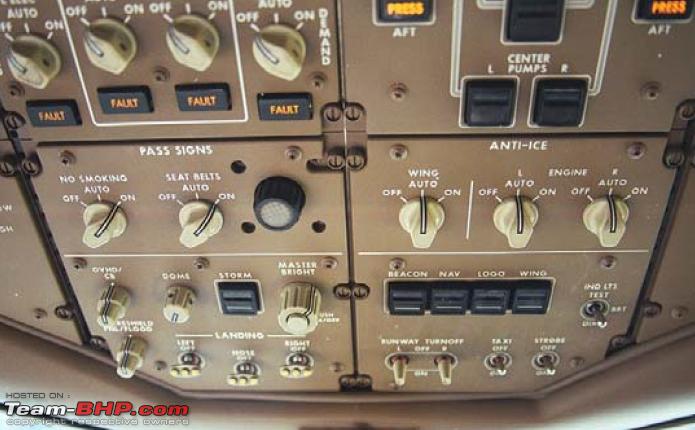
Quote:
Originally Posted by mathuranuj
(Post 4002521)
One question - Is there an indicator or a warning light that alerts the pilot about the need for deicing?
|
As said in the above paragraph, de-icing is automatic on the 777. But auto de-icing failure happens and has proved to be fatal in many situations. The 777, depending on the gravity of the failure, provides EICAS messages and warning light and beepers. I have attached a list of the warnings/caution messages which occur on de-icing failure.
List of de-icing related EICAS messages and warnings. 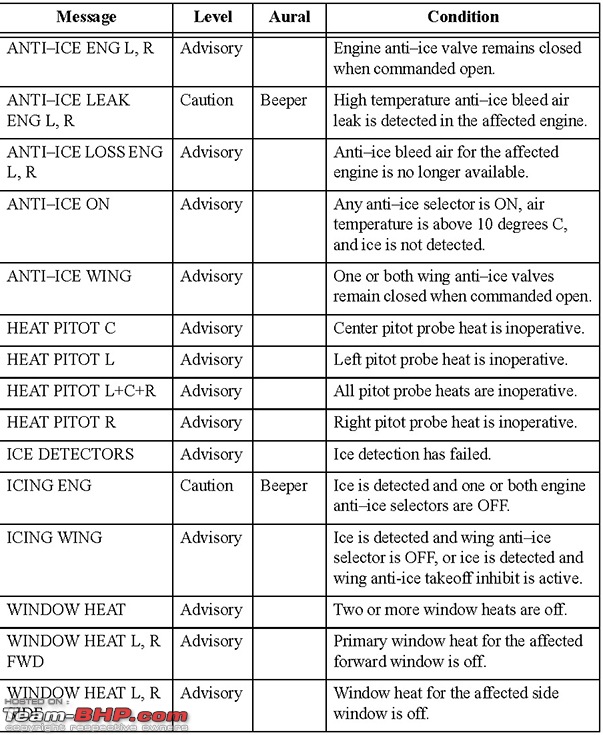
Quote:
Originally Posted by Gansan
(Post 4002106)
IAnd also the weight of those sitting on one side may be more or less than those sitting on the other. Is there any mean weight assumption? Also does the way passengers sit affect the trim? Say the aircraft is only half full, and all the passengers sit on the left or right side? Just curious!
|
Quote:
Originally Posted by Thad E Ginathom
(Post 4002507)
Passenger experience with weight distribution. Afterthought... if it is all in containers, how would he know?
|
Quote:
Originally Posted by Jeroen
(Post 4002556)
They know the weight of each container, so most likely they are shifting a few of the containers
|
This is going to be long. But I guess I cannot summarize this more than I already have. Please bear with me.
Weight and balance is important in any aircraft. We have a bit more flexibility in a heavy jet than the small turbo-props, but it's still critical. Balance of an aircraft is usually specified in terms of %MAC or %age of the Mean Aerodynamic Chord. For an aircraft to fly properly, the CG has to be within the limits of the flight safety envelope. If the CG is biased towards the front, then a nose heavy situation occurs. In such a case, we have to pull back the stick for a longer time and the take-off roll is longer. If the aircraft is tail heavy, there is a risk of tail strikes and will most certainly cause structural damage to the aircraft itself. Therefore, we have to ensure that the location of the CG lies between predetermined limits provided by the manufacturer. Also remember that apart from being within the safe flight envelope, we also want to be close to an optimal CG location. For the 777-300 a zero fuel weight CG of 26.6 percent of the mean aerodynamic chord is the usual aiming point. This is done to minimize fuel burn while still staying within limits as fuel is burnt.
Process
First off, we do not weight each and every passenger and/or his baggage. Weights are assumed to be an average value determined by the FAA. The average weight is now 86 kgs in summer and 88 kgs in winter. 4.5 kg for heavier clothing in winter and 2.26 kgs for clothing in summer. Cargo, however has a label on it with the weight of each block. Any containerized or palletized cargo is weighed at the freight terminal and delivered to the aircraft with labels telling the ramp what the total weight is.
Big commercial jetliners like the 777 are divided into zones. For the 777, there are 4 passenger compartment zones (0A – 0D), 4 service area zones (H - I), and five cargo zones (1-5). Each zone has a specified maximum capacity.
Zones 
All the loading calculation is done by a guy known as the Load Controller. He takes the cargo, passenger and fuel figures and performs calculations manually as well as on computer. The CG is verified by comparing both the manually calculated and computer calculated ones. We enter this value of CG in our FMC and the aircraft calculates the pitch trim required for that takeoff.
FMC pitch trim calculation according to CG. Photo taken at different times, ignore difference in gr. wt. 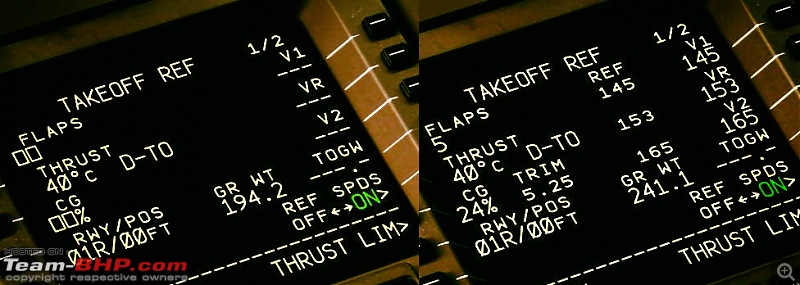
This is how a typical manual load and trim sheet looks for a manual calculation for the 777-300ER. It looks complicated, doesn’t it? If you look closely, you can see that even our own baggage is counted. Also note the flight envelope in the bottom right corner.
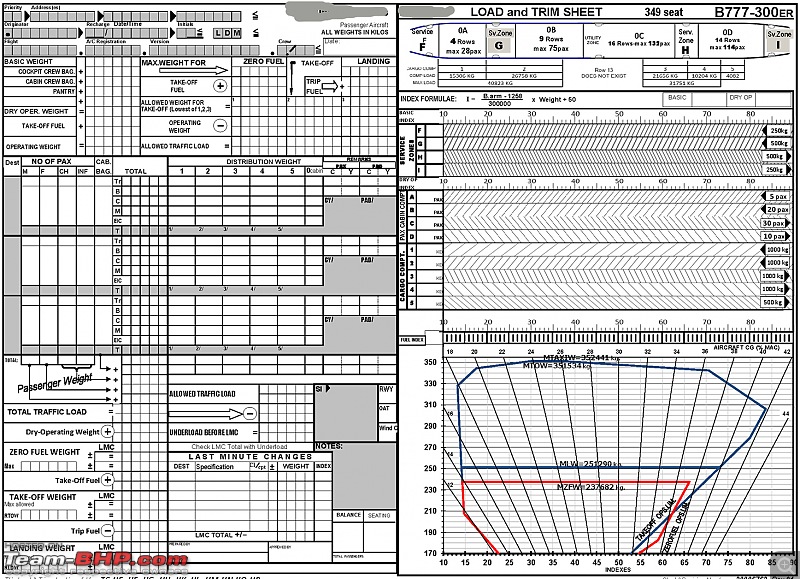 Typical timeline of the loading process.
Typical timeline of the loading process. - Cargo section provides cargo figures to load controller 3 hours before STD (Standard Time of Departure).
- Load Controller provides estimated Zero Fuel Weight figure to Flight Dispatch Section 2:45 before STD.
- In return Flight Dispatch Section will provide fuel figures and performance limited TOGW figure to load controller.
- 90 minutes before STD, the Load Controller prepares the Loading Advice form and hand it over to the Loading Supervisor.
- 20 minutes before STD the Load Controller is provided the traffic load figures.
- 15 minutes before STD the load sheet is completed and presented to us. We generally accept it. But time & experience teaches us a lot, and if we feel that the CG calculations look a bit off the mark, we can reject the load sheet and ask for a recalculation.
This is how the final computer generated load sheet calculation looks like. Takeoff CG 27.4 Value
Distribution is clearly mentioned in passenger and cargo compartments.
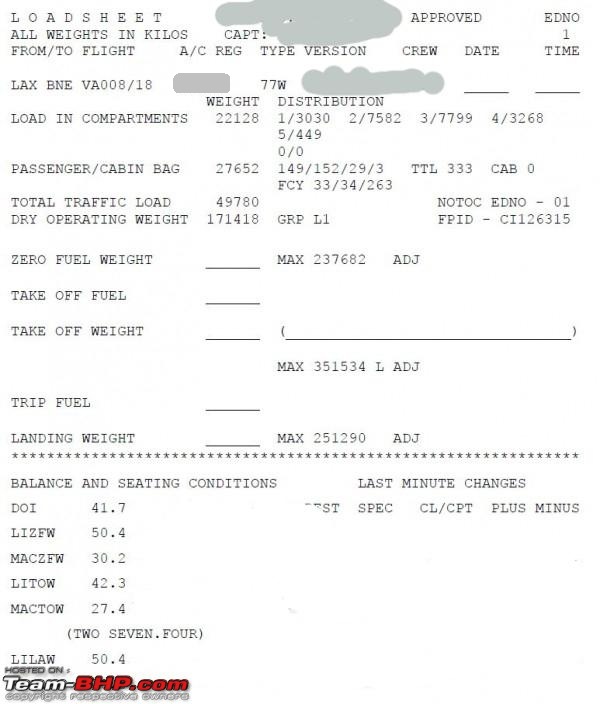
Quote:
Originally Posted by searchingheaven
(Post 4002672)
The anti–ice systems includes engine & wing anti–ice, along with flight deck window heat, and pitot probe heat. The 777 has an Automatic Ice Detection System(AIDS) which detects airplane icing in flight. The system consists of two ice detector probes on the forward fuselage. AIDS provides automatic deicing when the aircraft is in the air when the anti-ice switches are set to auto. These switches can also be manually switched on or off.
.
|
Thanks for these elobarate detailled answers. I was wondering, what with AIDS does it really always detect ice built up. Of course, when there is a system fault, you might get alarms. I meant more, are there occassion where you might have ice building up, that is not detected by any sensor. So it might show up as for instance engine problems (vibration) or stall situation.
I'm just flying little GA planes. Icing was and still is my biggest concern. Any chance of icing condition, just don't go there. I have flown with the Cirrus equipped with TKS system, so technically they are certified to fly into known icing conditions. Never had the guts to do so. It was scary enough to encounter some moderate icing conditions!
Bit more rudimentary then on the 777, still it does the job
https://www.youtube.com/watch?v=H9iQZOxrXi8
| All times are GMT +5.5. The time now is 05:29. | |







